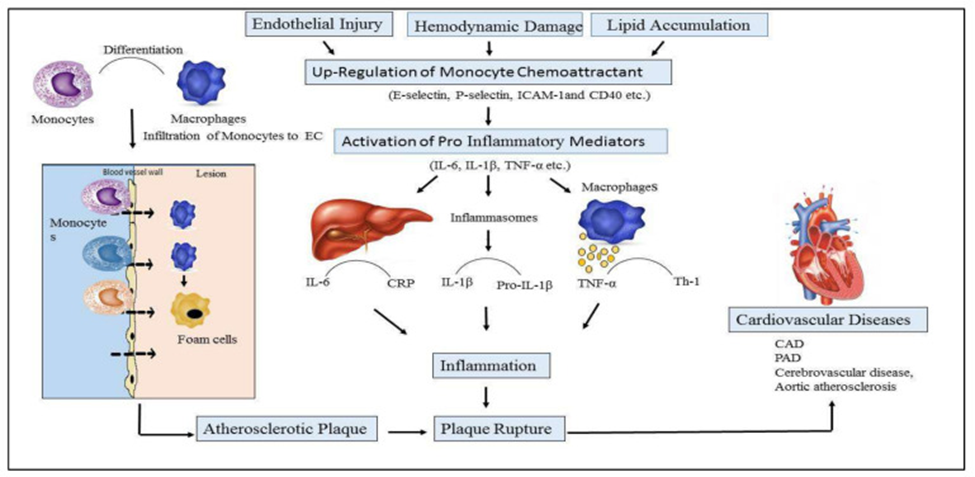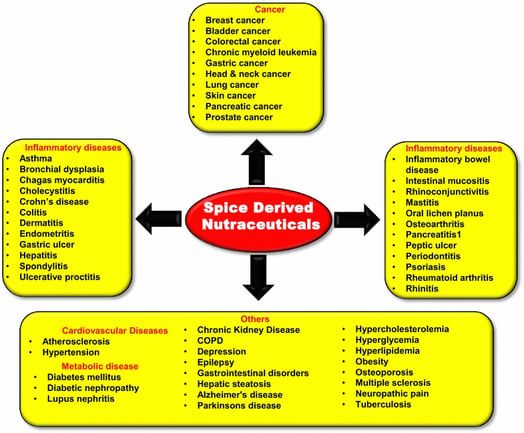Inflammation is a vital immune mechanism designed to protect the body against harm, yet when prolonged, it poses significant health risks. This biological process responds to various harmful stimuli, such as pathogens, toxic chemicals, or physical injuries.
While acute inflammation is a short-term, beneficial reaction involving symptoms like pain, heat, redness, and swelling, chronic inflammation is more insidious. It emerges slowly, persists over a long duration, and often lacks the pronounced symptoms of its acute counterpart.
Chronic inflammation is particularly concerning as it is primarily driven by monocytes, macrophages, and lymphocytes, leading to tissue damage, fibrosis, and an array of systemic symptoms including fatigue, mood disorders, and gastrointestinal issues.
Role of inflammation and cytokines in the pathophysiology of cardiovascular disease

Source: Ain, Qurrat Ul et al. “Confounders in Identification and Analysis of Inflammatory Biomarkers in Cardiovascular Diseases.” Biomolecules vol. 11,10 1464. 5 Oct. 2021, doi:10.3390/biom11101464 This article is an open access article distributed under the terms and conditions of the Creative Commons Attribution (CC BY) license (https://creativecommons.org/licenses/by/4.0/).
Chronic inflammation is linked to numerous disorders and diseases, with its role often signified by the suffix “itis,” as in arthritis or periodontitis. This persistent inflammation can result from various factors, including unresolved acute inflammation, autoimmune responses, and continuous exposure to irritants like industrial chemicals or harmful lifestyle habits.
Furthermore, risk factors such as aging, poor diet, obesity, smoking, sleep disorders, and stress significantly contribute to the onset and progression of chronic inflammation. The impact of chronic inflammation is vast, underpinning major health concerns like cardiovascular disease, diabetes, and various autoimmune disorders, making it a leading cause of death globally.
Lifestyle choices play a pivotal role in managing and potentially mitigating chronic inflammation. Elevated levels of certain biomarkers, such as C-reactive protein (CRP) and fibrinogen, are indicative of inflammatory processes and are influenced by factors including abdominal obesity, high blood glucose, and a sedentary lifestyle.
Monitoring these biomarkers is crucial for detecting and managing inflammation-related conditions and evaluating treatment effectiveness. Moreover, adopting an anti-inflammatory lifestyle is paramount in combating chronic inflammation.
This involves dietary adjustments to favor anti-inflammatory foods, reducing the intake of harmful substances, engaging in regular physical activity, ensuring adequate sleep, and managing stress effectively.
Common blood biomarkers associated with inflammation
- Adiponectin (Low)
- Albumin (Low)
- Asymmetric Dimethylarginine and Symmetric Dimethylarginine
- Bilirubin (Low)
- Copper-Zinc Ratio
- C-reactive Protein CRP and hs-CRP
- D-dimer
- Erythrocyte Sedimentation Rate (ESR)
- Ferritin
- Fibrinogen
- GlycA
- Homocysteine
- Leptin
- Lp-PLA2
- Mean Platelet Volume (Low)
- Myeloperoxidase
- Neutrophil:Lymphocyte Ratio
- Omega-3 Index (Low)
- Platelet:Lymphocyte Ratio
- Small-dense LDLs
- Trimethylamine N-oxide (TMAO)
- Uric Acid
- Vitamins (Low)AB6CD
- White Blood Cells
Addressing inflammation
Addressing inflammation requires a multifaceted approach encompassing both lifestyle changes and awareness of one's health status. Strategies like adhering to a Mediterranean-style diet and engaging in moderate physical activities have been shown to significantly reduce inflammation markers like CRP. Some herbs and spices have anti-inflammatory effects as well, including clove, coriander, garlic, ginger, onion, pepper, and turmeric.
Spice-derived nutraceuticals against various chronic diseases

Source: Kunnumakkara, Ajaikumar B et al. “Chronic diseases, inflammation, and spices: how are they linked?.” Journal of translational medicine vol. 16,1 14. 25 Jan. 2018, doi:10.1186/s12967-018-1381-2 This article is distributed under the terms of the Creative Commons Attribution 4.0 International License (http://creativecommons.org/licenses/by/4.0/)
Furthermore, practices such as avoiding unnecessary medications, prioritizing sleep, and engaging in stress-relief activities like yoga and meditation contribute to a holistic approach to combating chronic inflammation.
While certain forms of exercise, especially those that are high-intensity or lead to overuse, can trigger inflammation, moderate-intensity exercise and innovative methods like whole-body vibration therapy have been recognized for their positive effects on reducing chronic inflammation.
Optimal Takeaways
There are several steps that can be taken to reduce chronic inflammation and the risk of chronic disease (Pahwa 2023):
- Increase uptake of anti-inflammatory foods:
- It is important to avoid eating simple sugars, refined carbohydrates, high-glycemic foods, trans fats, and hydrogenated oils.
- Consuming whole grains, natural foods, plenty of vegetables and fruits such as avocados, cherries, kale, and fatty fish like salmon is helpful in defeating inflammation.
- Minimize intake of antibiotics and NSAIDs:
- Use of antibiotics, antacids, and NSAIDs should be avoided as it could harm the microbiome in the gut causing inflammation in intestinal walls known as leaky gut which in turn releases toxins and triggers chronic, body-wide inflammation.
- Exercise regularly to maintain an optimum weight:
- It is largely known that adipose tissue in obese or overweight individuals induces low-grade systemic inflammation.
- Regular exercise is helpful not only in controlling weight but also decreasing the risk of cardiovascular diseases and strengthening the heart, muscles, and bones.
- Sleep longer:
- Overnight sleep (ideally at least 7 to 8 hours) helps stimulating human growth hormones and testosterone in the body to rebuild itself.
- Stress Less:
- Chronic psychological stress is linked to greater risk for depression, heart disease and body losing its ability to regulate the inflammatory response and normal defense.
- Yoga and meditation are helpful in alleviating stress-induced inflammation and its harmful effects on the body.
References
Ain, Qurrat Ul et al. “Confounders in Identification and Analysis of Inflammatory Biomarkers in Cardiovascular Diseases.” Biomolecules vol. 11,10 1464. 5 Oct. 2021, doi:10.3390/biom11101464
Kunnumakkara, Ajaikumar B et al. “Chronic diseases, inflammation, and spices: how are they linked?.” Journal of translational medicine vol. 16,1 14. 25 Jan. 2018, doi:10.1186/s12967-018-1381-2
Morcuende, Alvaro et al. “Inflammatory Biomarkers in Addictive Disorders.” Biomolecules vol. 11,12 1824. 3 Dec. 2021, doi:10.3390/biom11121824
Moreira-Marconi, Eloá et al. “Inflammatory Biomarker Responses to Whole-Body Vibration in Subjects with Different Clinical Status: A Systematic Review.” International journal of environmental research and public health vol. 19,22 14853. 11 Nov. 2022, doi:10.3390/ijerph192214853
Pahwa, Roma, et al. “Chronic Inflammation.” StatPearls, StatPearls Publishing, 7 August 2023. This book is distributed under the terms of the Creative Commons Attribution-NonCommercial-NoDerivatives 4.0 International (CC BY-NC-ND 4.0) ( http://creativecommons.org/licenses/by-nc-nd/
Stone, William L., et al. “Pathology, Inflammation.” StatPearls, StatPearls Publishing, 14 November 2022.







